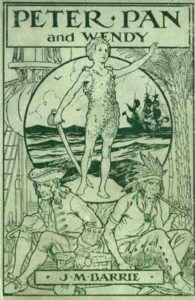Book Review: Peter Pan by J.M. Barrie
All of us have visited the Neverland, but relatively few remember, for most children go there only in their imaginations. Only a handful ever come in person, and just one always returns. He is the boy that will never grow up, Peter Pan.
Peter is both beautiful and terrifying, joyous and savage. He is heroic, but doesn’t really understand how good and evil work, and will not hesitate to kill when it is convenient or fun. He disdains actual mothers, but wants a girl to act as a mother for him and any Lost Boys that Peter happens to have accumulated. This is the story of how Peter convinced Wendy to be that temporary mother.
Originally titled Peter Pan and Wendy, this 1911 book was based on J.M. Barrie’s (1860-1937) 1904 play, which had been a huge success. It fleshes out many of the people in the play and gives more insight into their behavior.
The Darling family is rather eccentric even before Peter shows up. Mr. Darling is off his meds, Mrs. Darling has a mind like a puzzle box, nursemaid Nana is a dog, and the other servant Liza is…older than ten, but not by much. By comparison, Wendy, John and Michael with their childish imaginations seem perfectly normal.
It’s near Christmas, and the Darling parents have been invited to a party a few houses away. While getting the children to bed, Mr. Darling commits a particularly dastardly act and to deflect responsibility, removes Nana from the nursery and sticks her in the yard, leaving the children undefended.
But then, even though Mrs. Darling had previously discovered Peter Pan’s shadow lying about the room, who would have suspected that the eternal boy would be back that very night? Wendy has already learned some motherly skills, and decides to help Peter by sewing his shadow back on. Peter cozens Wendy into coming to the Neverland with him to be his mother, and takes John and Michael along because Wendy insists.
Trouble begins even before the children reach the Neverland, as Peter’s fairy companion Tinker Bell has become insanely jealous of Wendy and tries to get her murdered. (Peter never figures out why Tink is upset. He’s big enough for both girls to be his friend.) Fortunately, that plot doesn’t quite work out, and the Darling children join the Lost Boys, young fellows who fell out of their perambulators and Peter “rescued.”
The Neverland is an island created and influenced by children’s imaginations, especially British children, so it is full of adventure. Wild beasts of all kinds, “redskins”, and pirates are constant threats, and there are mermaids in the lagoon. Wendy has an imaginary wolf cub pet in her daydreams, and in the Neverland, that wolf is real (but largely ignored.)
The leader of the pirates is Captain Hook, an over-the-top scoundrel who hates Peter Pan for cutting off his hand and feeding it to a crocodile. It’s his enmity that drives the last half of the book as Hook attempts to kill Peter Pan and the Lost Boys and secure Wendy to be “mother” for himself and his crew.
As the Darling children enjoy their stay in the Neverland, Wendy realizes they are losing their memories of home, and has enough empathy to worry about her parents’ sorrow at having their children abducted. But when they try to leave, Captain Hook strikes! It’s time for one last adventure, and this time Peter Pan swears it’s Hook or him.
In the final chapter, the children are returned to the real world, and the Darlings adopt the Lost Boys, but Peter promises only to visit. A year later, Peter doesn’t remember Captain Hook or Tinker Bell(!), and soon loses track of when to pick up Wendy. He returns for adventures with Wendy’s daughter Jane, and Jane’s daughter Margaret, and this will continue “as long as children are gay and innocent and heartless.”
The fashion has been for a while to make “dark reimaginings” of beloved children’s tales, but this is a book that is plenty creepy all on its own. Consider, for example, the offhand reveal that Peter “changed” John to fit inside a tree. This is never expanded on nor reversed. And Michael, who is all of four years old, kills a pirate in combat.
More unsettling for a modern audience is the racism. The Neverland in this book is heavily influenced by children’s adventure stories of the late Victorian/early Edwardian period, and at the time, it was politically correct to depict aboriginal peoples as “savages.” Noble savages sometimes, but still. Likewise, the pirates owe more to Treasure Island than to historical accuracy. Parents reading this to or with their children should brace for conversations about how depictions of native people have changed and why.
(A modern version of the Neverland would presumably reflect today’s children’s adventure stories, full of ninja and dark wizards and talking ponies. It’d probably also have a better gender balance, if not better gender politics.)
Recommended to fans of dark fantasy (seriously, this book is only one step removed from a horror story) and families whose children are ready for a more challenging version of the beloved character.

